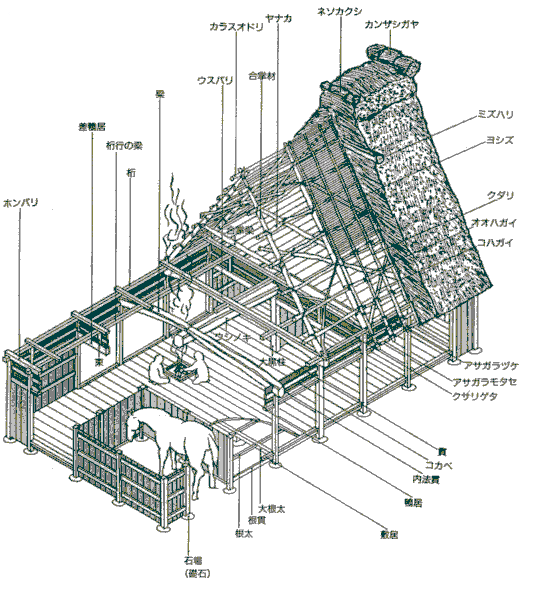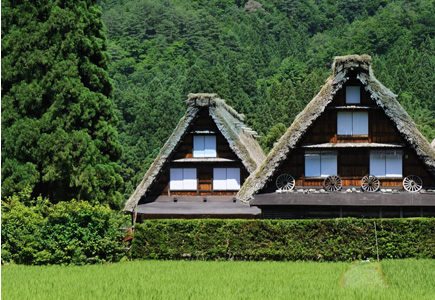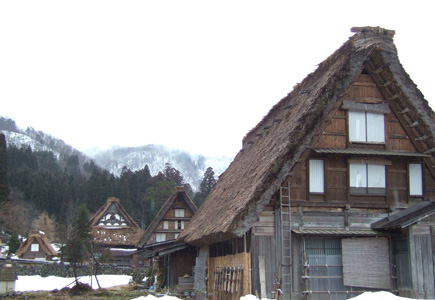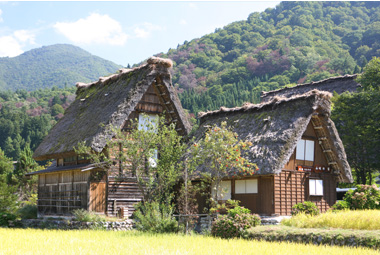-
Gassho-zukuri is a house built of wooden beams combined to form a steep thatched roof that resembles two hands together. You can see houses such as these in other parts of the country. In Shirakawa, they are called "Kiritsuma- Gassho-zukuri," and the roof can be looked triangular just like a standing book open.It is the characteristic of these houses in this country.The structure is built to suit the environment in Shirakawa. It is made to with stand heavy snowfall.
The house face north and south, to minimize wind resistance.
They are also built for be comfort in both summer and winter. The houses stand in a certain direction to adjust the amount of sun in order to keep the room cool in the summer and warm in the winter.Illustrator: Toshikazu Takahashi
from How many Gassho-zukuri houses can be created? A record of the Transmission of Shirakawago Techniques
Published by Shirakawa Village Board of Education / Edited by the People's Cultural Images Research Institute -


-

-
Gassho-zukuri houses were built from the middle of the Edo Period to the beginning of the Showa Period in the area from Shirakawa Village to the Gokayama district in Fukui Prefecture. The oldest buildings are said to be 300 years old. However, numbers decreased from 1945 onwards due to submersion through dam projects to develop electrical power resources from the Shogawa River. Further, there were mass exoduses from smaller settlements or they disappeared due to fire and Gassho houses were re-sold or disappeared. The approximately 300 houses that existed in 1924 had decreased severely to 190 by 1961.
Under such circumstances, from 1965 onwards, Ogimachi settlement community residents began to organise a movement to preserve the Shirakawa Village Gassho-zukuri before it disappeared.
In 1971, three basic rules were set out: not to sell, rent out or destroy resources within the community and a consensus of opinion among all the residents launched the Association for the Preservation of the Natural Environment of the Shirakawa Ogimachi Settlement and this developed preservation activities.
These preservation activities were recognised and in 1976, it was designated nationally as an important traditional architectural preservation area and registered as a World Heritage Site in 1995.
In 1997, the World Heritage Site Shirakawago Gassho-zukuri Preservation Foundation was established and it conducts scenery preservation activities.
-

-
●Height above sea level: 496m
●Designated as a National Cultural Traditional Architectural Preservation Area 4th September, 1976
●Registered as a World Heritage Site 9th December, 1995
●Area: 45.6ha●No. of structures Gassho-zukuri structures: 114 (109 of which are designated as traditional architectural structures) Non-Gassho-zukuri structures: 329 (8 of which are designated as traditional architectural structures) Manufactured articles: 7 (Shinto shrine archways, hanging lanterns, stone walls) Environmental: 8 (company business, trees, waterways, etc.) ●Population: approx. 600, No. of households: approx. 150
●Association for the Preservation of the Natural Environment of the Shirakawa Ogimachi Settlement Official Website

-
The reason that the Shirakawago Gassho-zukuri became so widely known is said to be due to the mention of Gassho-zukuri in 'Rediscovering the Beauty of Japan' written by the famous German architect, Bruno Taut (1880-1938).
Bruno Taut spent more than 3 years in Japan travelling all over the country and rediscovering the beauty of Japan. He visited Shirakawago in May of 1935.
In his book, Bruno Taut praised the 'Gassho-zukuri houses as architecturally rational and logical' and stated that 'this scenery is not typically Japanese. At the very least, it is not the kind of scenery I have ever seen before. This is more Swiss, otherwise an illusion of Switzerland.' Due to this high praise, it became the focus of attention of people from all over the world. -


















